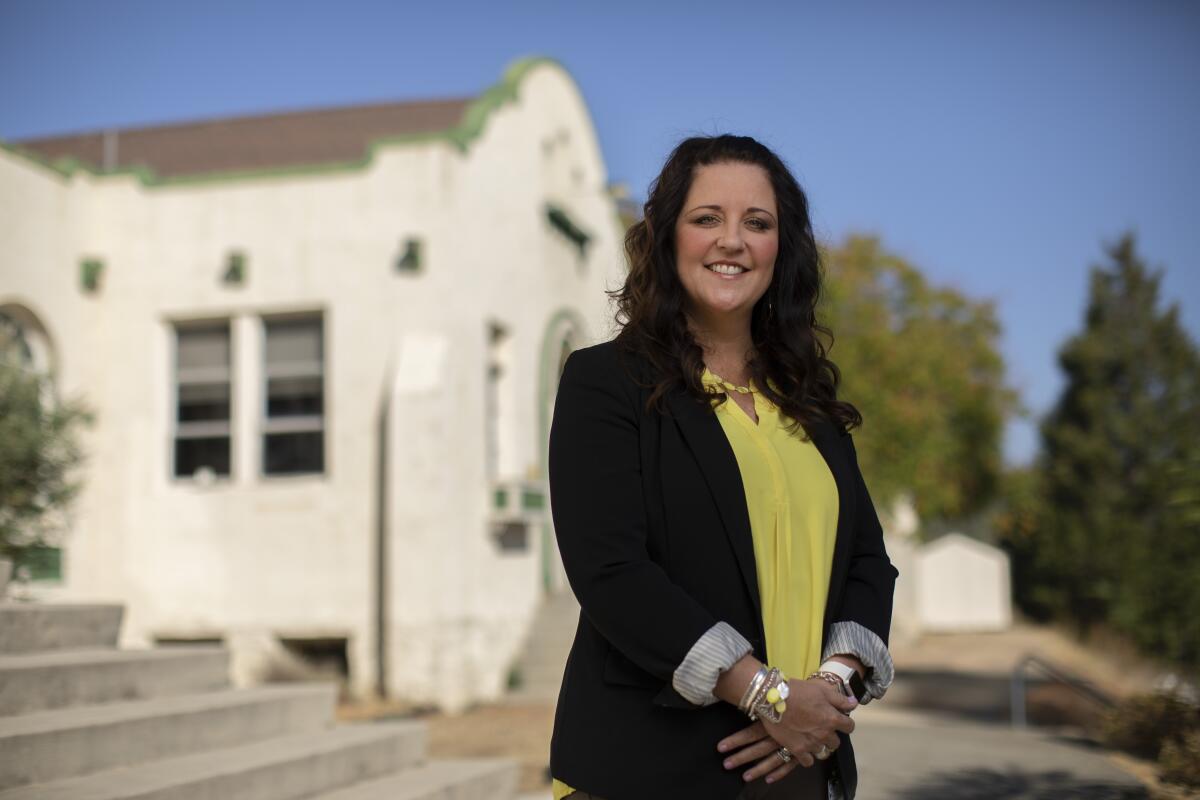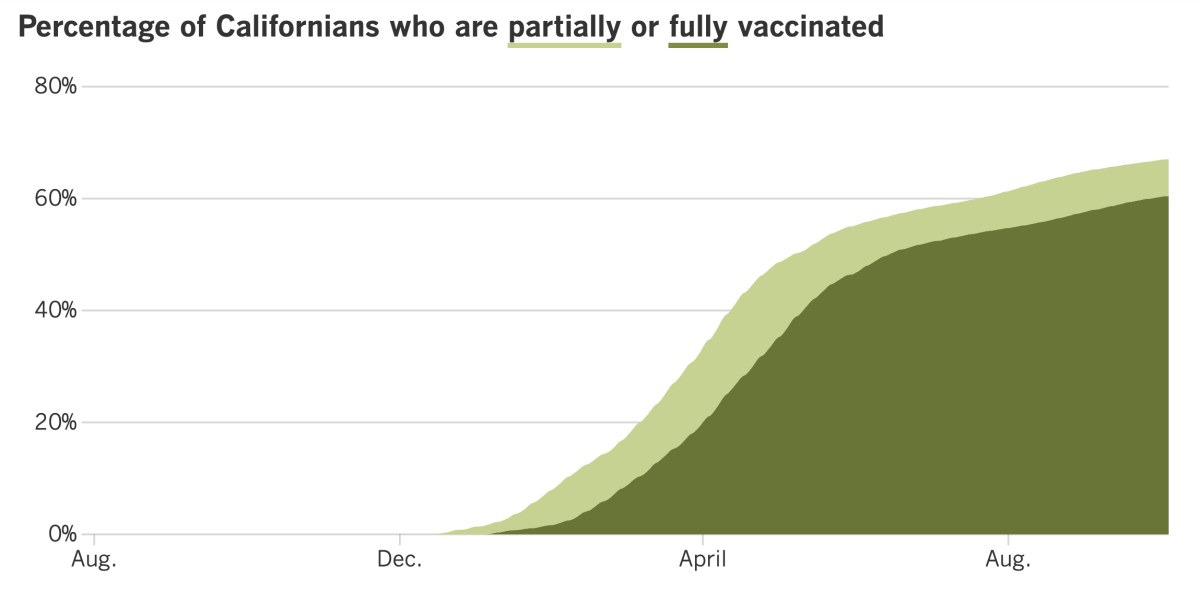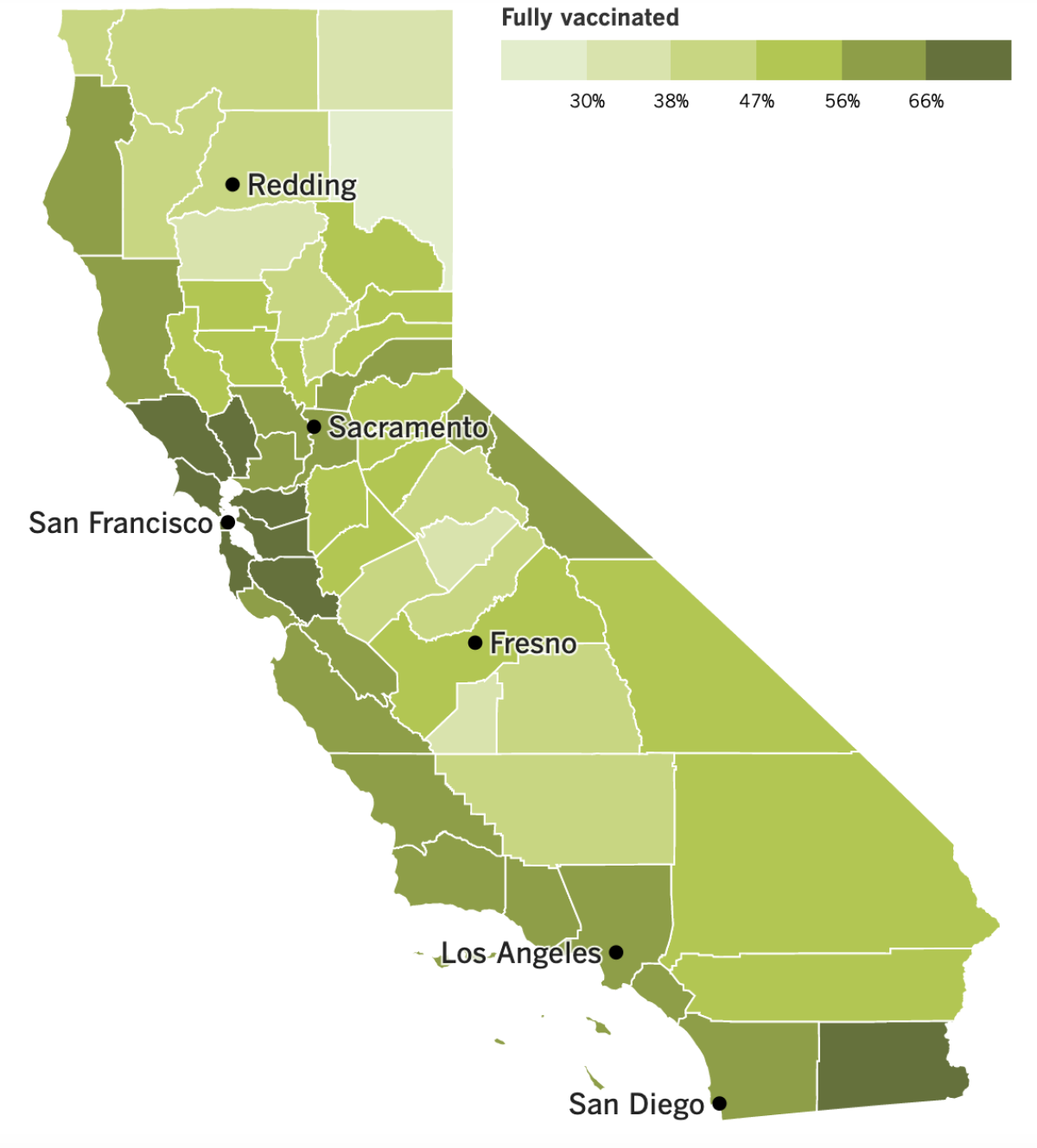Coronavirus Today: Death threats over face masks
Good evening. I’m Karen Kaplan, and it’s Tuesday, Oct. 5. Here’s the latest on what’s happening with the coronavirus in California and beyond.
The coronavirus keeps finding new ways to surprise us. The latest example: Rules about face masks have resulted in death threats.
I get that no one really enjoys wearing a face mask. But it’s hard to see what makes it so awful — even in principle — that a death threat would be warranted.
Yet Torie Gibson has received them because it’s her job, as superintendent for the Amador County Unified School District, to enforce rules requiring students to wear masks inside classrooms.
It was in her district that a parent went viral for punching a teacher after his fourth-grade daughter exited Sutter Creek Elementary School with a mask on her face. The man “just flipped his lid” because he saw maskless adults inside the teachers’ lounge, Gibson said. (That’s allowed if all teachers are vaccinated and no students are present.) The teacher, who was struck several times in the head and face, still has vision problems nearly two months after the attack.
It’s tempting to dismiss this case as a one-off, but as my colleague Hailey Branson-Potts reports, opponents of mask and vaccine mandates are putting educators in danger across the country.

Indeed, people who are fed up with the way the pandemic has circumscribed everyday life are taking their anger and frustration out on schools. Some of the demonstrators don’t even have children in the schools they’re protesting.
The National School Boards Assn. said in a letter to President Biden that the threats and attacks were “the equivalent to a form of domestic terrorism and hate crimes.” The group asked the Department of Justice, the FBI, the Department of Homeland Security and the Secret Service for assistance.
Is that really necessary? Ask the principal of an Arizona elementary school that had ordered a boy to quarantine because he’d been in close contact with someone with a coronavirus infection. The boy’s father and two other men came to the school with zip ties and threatened the principal with citizen’s arrest.
Or you can ask members of the Broward School Board in Fort Lauderdale, Fla., whose mere consideration of a mask mandate prompted one protester to pour lighter fluid on a tray of masks and then light them on fire.
You can even try the Poway Unified School District board members whose meeting was interrupted by trespassing anti-mask protesters as San Diego Police Department officers did nothing to stop them. The officers advised the board to adjourn, and after they did, the protesters attempted to swear themselves in as replacements like it was Jan. 6.
It wasn’t the only time law enforcement officials declined a school board’s request to enforce a mask mandate or restore order in a meeting that had gone off the rails.
“In numerous cases, law enforcement officers — in brazen defiance of the law and their professional oath — have explicitly stated they will not enforce safety mandates or restrain those whose actions willfully disrupt a meeting and prevent it from proceeding,” Vernon M. Billy, chief executive of the California School Boards Assn., wrote in a letter to Gov. Gavin Newsom.
It’s unclear whether Newsom’s recently announced statewide COVID-19 vaccine mandate for all age-eligible students will make the situation better or worse. On one hand, it could take some pressure off local school administrators. On the other hand, “in areas where there is strong resistance, it could intensify the backlash,” said Troy Flint, a spokesman for the state’s school boards group.
Chip Slaven, the interim executive director of the National School Boards Assn., said much of the vitriol and violence were fueled by misinformation and conspiracy theories.
“America, everyone needs to take a step back here and take a deep breath,” he said.
By the numbers
California cases and deaths as of 5 p.m. Tuesday:

Track California’s coronavirus spread and vaccination efforts — including the latest numbers and how they break down — with our graphics.
How people with mental health challenges can help us cope with COVID-19
The pandemic has brought stress, anxiety and depression into all of our lives. The Kaiser Family Foundation reports that about 40% of U.S. adults have suffered with depression or anxiety during the pandemic — roughly four times the percentage seen in America’s pre-pandemic days.
The strain on mental health manifests in a variety of ways, whether it’s sleep problems, alcohol or substance abuse, or the worsening of chronic health conditions. Coping is not always easy, but we all can learn a thing or two from people who have been dealing with mental health challenges long before the coronavirus ever hit our shores.
My colleagues reached out to the folks at Painted Brain, a mental health nonprofit, to gain some perspective. They also spoke with psychologist Marlene Valter, the founder of a company called AnaVault that supports people with mental health challenges. Among other things, she provides training in resiliency, which can help us cope without putting our mental health at risk.

Here are Valter’s six steps to resilience:
1. Self-regulation
Valter says this is the foundation of resilience. It refers to “the ability to manage your emotions and behavior even in the face of trauma,” my colleagues write.
When faced with a situation that seems dangerous, a resilient person has learned not to be impulsive and reactive. Until our bodies are in relaxation mode, we can’t access the judgment, creativity and decision-making skills we need to sort out whether a threat is real or merely a reminder of something from the past.
It can take just five to 10 seconds to relax the muscles of your body, progressing from head to toe. The process should be repeated dozens of times a day.
2. Intention
“Figure out your purpose,” my colleagues write. Then remember it. If we find ourselves acting against our intentions, we know it’s time to stop and reconsider what we’re doing.
3. Cognitive reframing and perception change
This involves stepping back and assessing how we’ve been looking at things in our lives. Be open to seeing them in a less rigid way.
As you do, Valter reminds you that “you can only change what you have control of.” If there are things out of our control that we’d like to change, it’s fine to advocate for that; just be sure to do it with intention.
4. Support
Identify the people who inspire you to be your best self. Don’t simply look for those who will validate you no matter what — you want people who will give you honest feedback even when it may be hard to hear.
“Find the people who care about you,” Valter says, “who make you feel free to be yourself.”
5. Grit
Becoming resilient isn’t a one-time process. It’s work that must be done over and over as life throws unexpected challenges our way. Grit is what will make us want to get through these challenging moments so we can stay on the path.
6. Self-care
This goes beyond the basics such as a healthy diet, enough sleep and regular exercise. We also need to practice self-care when we’re triggered by something stressful, so that we can relax those muscles and face the situation in the best possible frame of mind.
Finding distractions that get us into relaxation mode is also good for our mental health, Valter says. A distraction need not last long — even a few minutes may be enough to get into a different headspace and stave off feelings of burnout.
Remember, the goal is not to live a stress-free life. It’s about managing that stress so we don’t burn out.
“If you want to be challenged, go for it,” Valter says. “Just add these parts into your daily routine, and you will be OK.”
Suicide prevention and crisis counseling resources
If you or someone you know is struggling with suicidal thoughts, seek help from a professional and call 9-8-8. The United States’ first nationwide three-digit mental health crisis hotline 988 will connect callers with trained mental health counselors. Text “HOME” to 741741 in the U.S. and Canada to reach the Crisis Text Line.
California’s vaccination progress


See the latest on California’s vaccination progress with our tracker.
Your support helps us deliver the news that matters most.
In other news ...
The U.S. reached another grim milestone since our last edition, recording its 700,000th death due to COVID-19. That’s greater than the populations of Washington, D.C., Nashville, Boston or Las Vegas.
Perhaps it was inevitable that we would hit that number. But public health officials lament that it needn’t have happened so soon. The last 100,000 of those deaths occurred in just 3½ months despite the wide availability of COVID-19 vaccines to any American age 12 or older.
At least 70,000 of the most recent 100,000 deaths were in unvaccinated people, said Dr. David Dowdy, an infectious disease epidemiologist at Johns Hopkins Bloomberg School of Public Health. Among the vaccinated people who died as the result of breakthrough infections, most caught the virus from an unvaccinated person, he said.
The state with the most deaths during this stretch was Florida (about 17,000), followed by Texas (13,000). Together, they accounted for about 30% of the recent deaths despite being home to just 15% of the U.S. population.
State and local leaders across the country were eager to receive billions of dollars in federal COVID-19 relief funds to fortify their balance sheets and revive their communities. The money from the American Rescue Plan has been available since May, but as of the summer, a majority of large cities and states have yet to spend a penny.
The Associated Press reviewed financial reports for the program and found that states had spent only 2.5% of their initial allotment. The cities had spent just 8.5% of available funds.
In some cases, the holdup is due to the fact that the funds were released by the U.S. Treasury Department after state legislatures had wrapped up their budgets, so governors had no authority to spend Rescue Plan funds. In other cases, cities have been soliciting ideas from residents before requesting money. And some officials say they still have money left over from previous rounds of pandemic aid or have been doing fine on their own.
The law frees up $350 billion to be spent on a wide array of programs. States have until the end of 2024 to come up with spending plans, and through the end of 2026 to actually use the cash.
Gene Sperling, the White House American Rescue Plan coordinator, said the slow start wasn’t a problem since the money was intended to address “crisis needs” as well as “longer-term firepower to ensure a durable and equitable recovery.”
Arizona has received some money and used it to fund education grants. But there’s a hitch: Schools with mask mandates aren’t eligible for the grants.
That’s a no-go for the Biden administration. On Tuesday, the Treasury Department sent a letter to Gov. Doug Ducey informing him that the grant program he set up was “not a permissible use” of the federal relief funds because the conditions of the grants “undermine evidence-based efforts to stop the spread of COVID-19.”
A Ducey spokesman said the governor’s office was reviewing the letter.
On the vaccine front, a new study based on 3.5 million Kaiser Permanente patients in Southern California adds to evidence that the Pfizer-BioNTech vaccine’s protection against breakthrough infections erodes rather quickly. By comparing coronavirus infection rates for patients who got the vaccine and for those who didn’t, researchers determined that the vaccine’s effectiveness fell from 88% in the first month to just 47% after five months.
The data strongly suggested that the rise of the highly transmissible Delta variant wasn’t to blame. A person freshly inoculated with the vaccine had the same initial level of protection against Delta as against other coronavirus variants. In addition, breakthrough infections were more closely linked to the amount of time since vaccination than to the particular variant involved.
Also, the vaccine’s ability to keep COVID-19 patients out of the hospital remained high across a period of time when Delta gained ground in Southern California. In fact, the vaccine’s effectiveness at preventing hospitalizations held steady at close to 90% for as long as six months — and it maintained that power across people of all age groups. The findings were published Monday in the journal Lancet.
Johnson & Johnson filed a request with the Food and Drug Administration on Tuesday to authorize booster shots of its COVID-19 vaccine. The booster dose would only be for people who previously received the company’s single-shot vaccine.
J&J’s regulatory filing included data on several booster intervals, ranging from two to six months after the initial dose. The company did not recommend any particular option, though it has released data showing that the vaccine remained 81% effective at preventing COVID-19 hospitalizations for at least five months.
An FDA advisory committee will review J&J’s data a week from Friday and vote on whether the booster shots should be granted an emergency use authorization. The panel will also weigh booster data from Moderna. It’s possible that booster doses of both vaccines could be available by the end of October.
AstraZeneca’s COVID-19 vaccine is still in limbo in the U.S., but the company said Tuesday it had applied for emergency use authorization for its long-acting antibody treatment, which it says can prevent COVID-19 in people with compromised immune systems who don’t get enough protection from vaccines.
If the FDA agrees, the treatment would become the first medicine of its kind in the U.S. AstraZeneca’s head of research and development said the treatment was designed to boost immunity for up to a year.
Australia is wrapping up its second pandemic winter, and Aussies will soon be able to leave the country for the first time in 18 months.
On Friday, Prime Minister Scott Morrison said vaccinated citizens would be able to travel overseas starting in November. Then on Tuesday, he said skilled migrants and students would be able to return to the country once 80% of Australians age 16 and older were fully vaccinated — a benchmark the country is close to reaching.
Hoping to attend the 2022 Australian Open tennis tournament in January? That plan is still dicey, since Morrison said foreign tourists wouldn’t be welcomed back until sometime next year at the soonest.
And in (relatively) nearby New Zealand, Prime Minister Jacinda Ardern acknowledged a fact that most countries came to terms with long ago: It is impossible to get rid of the coronavirus completely.
To its credit, New Zealand came close. Its strict lockdowns and aggressive contact tracing have kept COVID-19 deaths to just 27 in a country of 5 million. But the Delta variant is too formidable to beat back. A traveler returning from Australia brought it to New Zealand in August, and the virus escaped a quarantine facility.
On Monday, Ardern said lockdown restrictions would be eased in Auckland even though an outbreak continued to simmer there.
“For this outbreak, it’s clear that long periods of heavy restrictions has not got us to zero cases,” she said. “But that is OK. Elimination was important because we didn’t have vaccines. Now we do, so we can begin to change the way we do things.”
Your questions answered
Today’s question comes from readers who want to know: When can we stop wearing masks indoors in Los Angeles County?
Not as soon as you might hope.
When the mandate was announced in mid-July, the county had averaged 1,077 new cases per day over the previous week. As of Tuesday, the county averaged 1,154 new cases per day over the previous week.
Things were much worse in August and September, and local health officials give their universal indoor mask mandate a big chunk of the credit for turning things around. So it’s unlikely they’d ditch it when there’s still so much work to do. That would be “like throwing away your umbrella in a rainstorm because you are not getting wet,” as Supreme Court Justice Ruth Bader Ginsburg famously put it in her dissent in a voting rights case.
The CDC advises people to wear masks in indoor public settings — regardless of their vaccination status — if they’re in places with “high” or “substantial” coronavirus transmission. L.A. County is currently in the “substantial” tier, with about 88 new cases per 100,000 people in the last week. To graduate to the “moderate” tier, that case rate would have to dip below 50 — and that could take a little while.
Besides, L.A. County Public Health Director Barbara Ferrer & Co. have not said exactly what criteria they’d use to determine when the indoor mask mandate can be retired, either for vaccinated or unvaccinated people.
“The most important measure that we’re looking at is getting back to low transmission,” she said last week. “Obviously, the lower the transmission, the less virus is circulating, the less chances we all have of either getting infected or infecting others.”
We want to hear from you. Email us your coronavirus questions, and we’ll do our best to answer them. Wondering if your question’s already been answered? Check out our archive here.
Resources
Need a vaccine? Keep in mind that supplies are limited, and getting one can be a challenge. Sign up for email updates, check your eligibility and, if you’re eligible, make an appointment where you live: City of Los Angeles | Los Angeles County | Kern County | Orange County | Riverside County | San Bernardino County | San Diego County | San Luis Obispo County | Santa Barbara County | Ventura County
Practice social distancing using these tips, and wear a mask or two.
Watch for symptoms such as fever, cough, shortness of breath, chills, shaking with chills, muscle pain, headache, sore throat and loss of taste or smell. Here’s what to look for and when.
Need to get tested? Here’s where you can in L.A. County and around California.
Americans are hurting in many ways. We have advice for helping kids cope, resources for people experiencing domestic abuse and a newsletter to help you make ends meet.
We’ve answered hundreds of readers’ questions. Explore them in our archive here.
For our most up-to-date coverage, visit our homepage and our Health section, get our breaking news alerts, and follow us on Twitter and Instagram.




